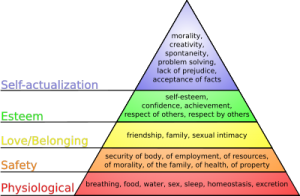Maslow’s Hierarchy and Meeting Learners’ Basic Needs
In his 1943 paper, A Theory of Human Motivation, psychologist Abraham Maslow , [2] proposed the idea that a person’s most basic needs must be satisfied before higher order needs can be addressed.
The needs he identified are:
- Physiological – includes air, food, water, sex, sleep, other factors towards homeostasis, etc.
- Safety – includes security of environment, employment, resources, health, property, etc.
- Belongingness – includes love, friendship, intimacy, family, etc.
- Esteem – includes confidence, self-esteem, achievement, respect, etc.
- Self-actualization – morality, creativity, problem solving, etc.
 As trainers, we must tend to our learners basic needs, before we can hope that they will embrace new material and grow in the ways we intend. Following are some tips that address the needs identified by Maslow.
As trainers, we must tend to our learners basic needs, before we can hope that they will embrace new material and grow in the ways we intend. Following are some tips that address the needs identified by Maslow.
Physiological – Our first order of business should be tending to our learners basic comfort. Let us be sure our group is well fed and hydrated; individuals must be told where the restrooms are and when they can expect to take a break; and the room must be maintained at a comfortable temperature.
Safety – Make sure that participants feel safe to be present, participate, speak, and share, without fear of ridicule. This is where an icebreaker can make or break an event — if the icebreaker pushes participants comfort zone and puts them on edge, we have failed. Alternatively, if it makes them feel safe, accepted and at ease with the challenge of learning something new, we have done our job well.
Belonging – Beyond making our participants feel safe, we must work towards creating a community of learners. Individuals will best be able to move on to higher order needs like self-actualization and learning if they feel supported by bonds of friendship and connection.
Esteem – Every single learner should feel valued. Often learners bring years of history and experience to learning events, which can be drawn out, honed, and celebrated.
Self-actualization – Trust that individuals have an inherent need and desire to learn and grow. Moreover, adult learners like to feel a sense of control over their personal development, growth, learning, and problem-solving. Use this innate desire to learn to your advantage by having participants work in teams, to collaborate and come up with observations, solutions or recommendations for others.
- Maslow’s Hierarchy of Needs
- Abraham H. Maslow, A Theory of Human Motivation, Psychological Review 50(4) (1943):370-96.


1 thought on “Maslow’s Hierarchy and Meeting Learners’ Basic Needs”